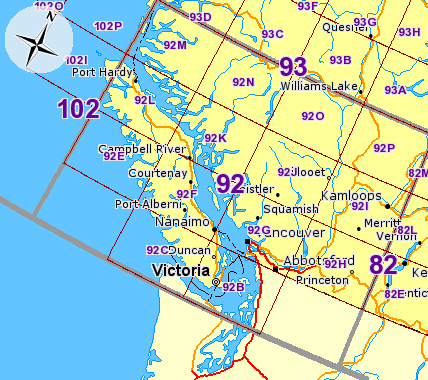| 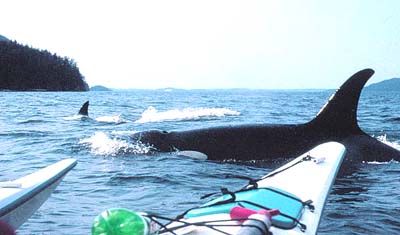
Photo courtesy Stathcone
Park Lodge
Alert Bay
I boarded a ferry at Port McNeil
at the northeastern end of Vancouver Island and soon arrived in
Alert Bay on Cormorant Island. I strolled along the waterfront past
piers, wharfs and dozens of boats bearing testimony to the main
pastime of fishing. The town is one of the main centres for First
Nations culture in British Columbia and overwhelming in its sensory
— and often contradictory — richness. A large war canoe
gleaming in red and white designs was pulled up past the high-tide
mark. Next to it a pier was covered with junk, including a cut up
airplane. Here and there totem poles reached majestically toward
the sky. I was touched, in particular, by the cemetery with its
extraordinary array of totems as well as crosses, a strange mixture
of Native and non-Native faiths.
Hemlock House
We boarded the Papillon, a 35-foot
converted gill netter that has seen better days, and chugged off
to Hemlock House Lodge on Swanson Island deep in the archipelago
of islands dotting the Inside Passage. As our boat puttered eastward,
we witnessed the immense natural wealth of the region, a wealth
that has supported the coastal First Nations for millennia. The
tail of a humpback whale rose high in the air as it started a deep
dive. A school of porpoises swam past, their silvery bodies performing
a graceful water ballet. Fishing boats cast their nets for sockeye
salmon as an eagle watched from its lofty nest.
With the sun low and the western sky bathed
in orange pastels, we arrived at the lodge and ferried our goods
onto a tiny sliver of sand and shells — the rest of the beach
was swallowed by an enormous high tide. While Dawson Simmonds, the
lodge owner, filleted a freshly caught sockeye salmon at water’s
edge, I sat on the deck and gazed onto Blackfish Sound. Within short
order a pod of Orcas paraded past, their tall dorsal fins carving
elegantly through the water. Then came the incongruous sight of
a tug pulling a barge of containers, followed later by a towering
gleaming-white cruise ship. Dawson explained that although located
in remote wilderness, the sound is on the shipping route between
Seattle and Alaska.
Next morning, a black bear ambled across
our beach. Then we boarded Papillon and crossed the sound
to Hanson Island. En route we saw a large school of Dal porpoises
gracefully swimming and leaping. An eagle high in a Douglas fir
guarded the entrance to the bay. We landed and hiked to a place
Dawson had mysteriously referred to as the “Earth Embassy.”
The Man Called Walrus
Inside a rickety deer-fence were about a
dozen structures looking much like a squatters’ camp. The
proprietor, David Garrick — aka Walrus — looked like
an ageing hippy with his green Nepalese silk head wrap, dirty gray
beard, and ponytail. But as I quickly learned, he is as intelligent
and articulate as any CEO, and much more fascinating. An anthropologist,
he has devoted himself since 1985 to identifying and studying “culturally
modified trees,” that is, cedars that have had their bark
harvested by Natives. In pursuing his goal to save the island from
further logging, he lives a simple Robinson Crusoe lifestyle with
no electricity and few modern conveniences.
The buildings are open-sided and made of
small logs, branches, plastic sheeting and, of course, duct tape.
We sat in his “living room,” which consists of a plank
floor, a tarp for a roof, and a few mildewed old chairs and log
circles for furniture, perhaps not like kings, but wonderfully close
to nature. Similar structures form the kitchen, his bedroom, and
a workshop. The library holds a treasure trove of files and photos
stored haphazardly in cardboard boxes of old Greenpeace campaigns
and his days as a Parliamentary Assistant in Ottawa. Another structure
forms the class room and laboratory where Walrus teaches courses
to Natives and visitors, many from Japan. A large sprawling garden
contains indigenous plants and vegetables with signs — the
letters painstakingly burned in with a magnifying glass —
announcing their names in Native, English, and Latin.
As we toured, Walrus recounted his early
days. One of the original Greenpeacers, he started the anti-whaling
movement in Japan in 1974, and later he worked with Paul Watson,
Greenpeace’s founder, to save wolves in British Columbia from
aerial killing. He also dates Mayan artifacts, and casually stated
that one time in Guatemala guerillas showed him how to sneak past
a village without waking a single dog.
Walrus led us through the forest and under
the enormous shadows of several gnarled old-growth patriarchs. He
indicated a tree with a red ribbon around it and a weal down the
side. “This is one of about 10,000 trees on the island that
were sustainably farmed for their bark, some for over 700 years,”
he explained. Cedar bark was used by Natives for hats, clothing,
rugs, boxes, rope and much more.
We puttered back to Hemlock House where I
sat on the deck while about 100 Pacific white-sided dolphin splashed
in the sound and pink clouds formed wreaths over distant peaks.
But I was oblivious to nature’s display. Instead, Walrus,
gentle dedicated Walrus, kept running through my mind. What drove
him? How could he turn his back on the comforts of this modern age?
Does it matter in the long run if his island is logged or not? That
night I dreamed of how the world might change if we could inject
some of Walrus’s philosophy into today’s materialistic,
it’s-all-about-me society.
Orcas!
In the morning we set out with another tantalizing
agenda. We crossed the sound to Hanson Island and were greeted by
Dr. Paul Spong, who, assisted by his wife Helena Symonds, has been
studying orca (aka “killer whales”) since 1970. A balding,
unassuming man, but with an underlying passion, he quietly explained
his research and led us through his internationally renowned Orca
Laboratory. An operations room, like a control tower perched at
the edge of the water with large windows overlooking the water monitors
whale traffic. Two volunteers from England and Japan were listening
to whales with headphones that receive signals from six hydrophones
covering about 50 square kilometres of the archipelago. In addition,
an underwater video camera is located at a nearby beach. The rising
and falling tones of orcas “talking” filled the room.
“That’s A5 pod,” announced one of the operators.
“We can identify virtually every single orca in the northern
group (about 220) by sight and by sound,” Spong explained,
“and have come to know a lot about their way of life.”
Spong described how a mother and all her
offspring, including males, live together for life as a close matrilineal
group; these groups are linked into pods. In his decades of research
he has seen no sign of fighting or territorial conflict. Orcas even
share their food when feeding on spring salmon, their favorite.
Modestly, Spong never mentioned that much of what is known of the
orca behaviour and their society is thanks to his research.
Spong is impressed by the orca’s generational
commitment to their group and the conflict-free nature of their
society. He feels humans have much to learn from them, but he is
concerned that instead we are threatening the very survival of orcas
and their main food — salmon — with pollution, over-fishing,
and global warming.
An Enchanted Forest
Then a crisis arose: our boat’s starter
motor failed and we could not depart. Stranded, I had time to explore
the island and entered an enchanted forest to visit Grandmother
Cedar, a 1300-year-old enormous titan. I trod soundlessly on a carpet
of moss while all around shafts of golden light peeked into the
understorey. There was an overwhelming sense of peace and comfort
in the dusky stillness of this grand forest, next to the towering,
gnarled ancient cedar tree.
Here and there stood immense Douglas fir
stumps, logged about a century ago. With nursery bushes sprouting
from their tops like unkempt patches of hair and the notches cut
for loggers’ planks looking like heinous grins, they were
like giant madmen of the forest, soundlessly, protesting that a
millennium of life has no worth in the human world.
Life Calls
Returning to the lab, I listened as the volunteers
related their experiences including the touching story of Springer.
Just a baby, it wandered off from its pod when its mother died.
It was found, kept in captivity for almost a year and then returned
to Hanson Island in 2004. Placed in a pen prior to release, the
other whales heard its calls and gathered around in a very excited
state with much vocalization and spyhopping (the head comes vertically
out of the water to see). Next day Springer was released and successfully
re-joined its original group. Amazingly, exactly one year later
the whales returned and held what appeared to be an anniversary
celebration.
With darkness falling, our boat was towed
back to Hemlock House. Rocked by the waves, I mused about orcas
and wondered at human conceit to consider ourselves the most intelligent
species in the world.
We awoke early to fix the boat and then motored
away over a sea draped in soft mist. Islands and fishing boats loomed
suddenly out of the mist and then disappeared quickly behind us
like ghosts. In Blowhole Pass my pulse quickened as our boat was
tossed around by eddies, whirlpools, and the fast-moving tidal water.
The sun came out and soon I was aboard a
ferry heading homeward. I gazed at the passing islands, reflected
on the rich marine life and the remarkable human beings I had encountered;
and I could already feel islomania setting in again.
If You Long for
an Island
Alert Bay is a 45-minute ferry ride from
Port McNeil (www.bcferries.com);
for accommodations check: www.alertbay.com/accomoda.htm
Hemlock House Lodge on Swanson Island offers
kayaking, and whale and wildlife watching tours: www.hemlockhouse.com.
To learn about orcas visit www.orcalab.org.
For travel, tourism, and accommodation information
on Vancouver Island visit www.vancouverisland.travel
and www.hellobc.com.
|
Islands
and Eccentrics in the Broughton Archipelago of British Columbia
by Hans Tammemagi 
I must
confess that I suffer from islomania, a rare malady in which islands
— especially wild, beautiful islands off the beaten path —
hold a sensuous allure and beckon to me irresistibly. Recently, my
affliction worsened so I sought relief by visiting the Broughton Archipelago
of British Columbia’s Inner Passage.
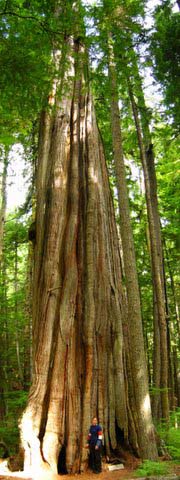
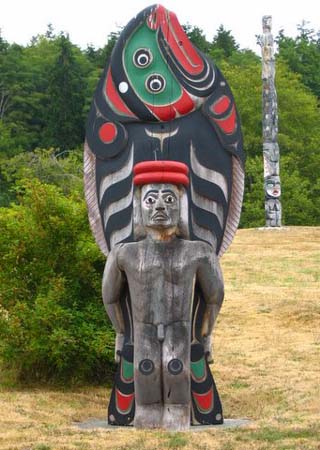
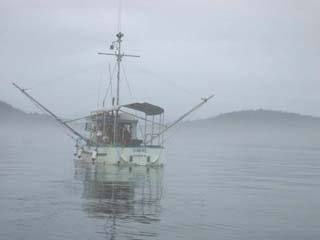
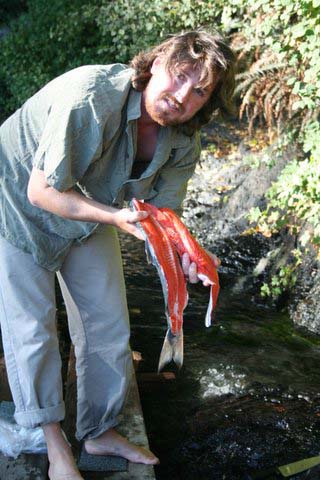
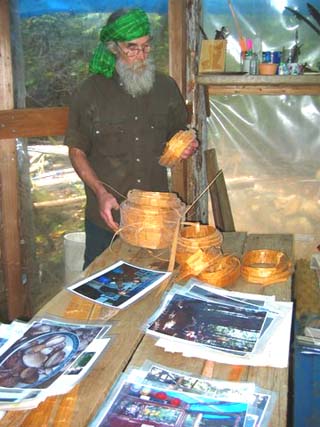
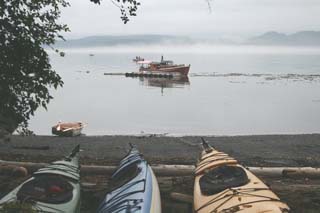
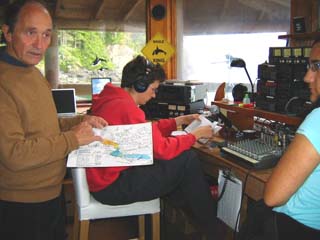
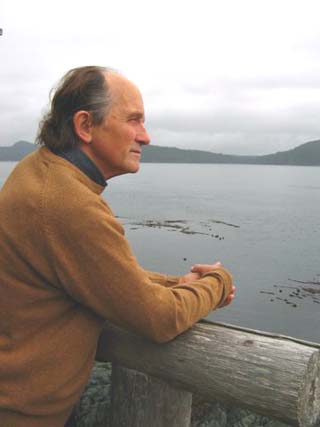
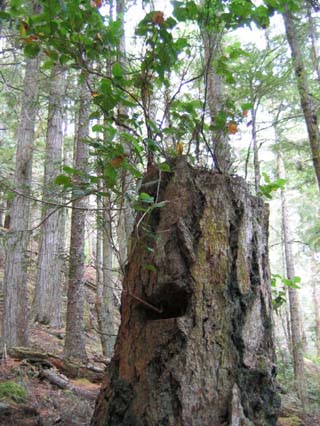
|
|










